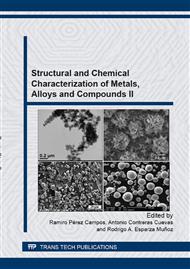[1]
Information on http://cdn.intechopen.com
Google Scholar
[2]
I. Abdulkadir, A. B. Aliyu, Afr. J. Pure Appl. Chem. 7 (2013) 114-121.
Google Scholar
[3]
N. Yahya, R.A. Habashi Masound, H. Daud, A.A. Aziz, and H.M. Zaid, Am. J. Eng. Appl. Sci. 2 (2009) 76-79.
Google Scholar
[4]
S.S. Shinde, R.A. Bansode, C.H. Bhosale and K.Y. Rajpure, J. Semicon. 32 (2011) 1-8.
Google Scholar
[5]
M. Fernández-García, J.A. Rodriguez, Metal Oxide Nanoparticles, Edited by Brookhaven National Laboratory. N.Y., (2007).
Google Scholar
[6]
V.M. Aroutiounian, V.M. Arakelyan, G.E. Shahnazaryan, G.M. Stepanyan, E.A. Khachaturyan, Heli Wang, John A. Turner, Sol. Energy 80 (2006) 1098–1111.
DOI: 10.1016/j.solener.2005.10.005
Google Scholar
[7]
H. Liu, Y. Wei, P. Li, Y. Zhang, Y. Sun, Catalytic synthesis of nanosized hematite particles in solution, Mater. Chem. Phys. 102 (2007) 1–6.
Google Scholar
[8]
A. Mao, K. Shin, J.K. Kim, D.H. Wang, G.Y. Han, J.H. Park, Controlled Synthesis of Vertically Aligned Hematite on Conducting Substrate for Photoelectrochemical Cells: Nanorods versus Nanotubes, Appl. Mater. Interfaces 3 (2011) 1852–1858.
DOI: 10.1021/am200407t
Google Scholar
[9]
P. Guo, Z. Wei, B. Wang, Y. Ding, H. Li, G. Zhang, X.S. Zhao, Controlled synthesis, magnetic and sensing properties of hematite nanorods and Microcapsules, Colloids Surf. A: Physicochem. Eng. Aspects 380 (2011) 234–240.
DOI: 10.1016/j.colsurfa.2011.02.026
Google Scholar
[10]
K. Supattarasakda, K. Petcharoen, T. Permpool, A. Sirivat, W. Lerdwijitjarud, Control of hematite nanoparticle size and shape by the chemical precipitation method, Powder Technol. 249 (2013) 353–359.
DOI: 10.1016/j.powtec.2013.08.042
Google Scholar
[11]
G. Carbajal-de la Torre, M.A. Espinosa-Medina, A. Martinez-Villafañe, J.G. Gonzalez-Rodriguez, V.M. Castaño, Study of ceramic and hybrid coatings produced by the sol-gel method for corrosion protection, The Open Corros. J. 2 (2009) 197-203.
DOI: 10.2174/1876503300902010197
Google Scholar
[12]
G. Carbajal-De La Torre, R. Nava-Mendoza, M.A. Espinosa-Medina, A. Martinez-VillafañeA, J.G. Gonzalez-Rodriguez, V.M. Castaño, Corrosion Protection of 1008 Carbon steel by Hybrid Coatings, Br. Corros. J. 37 (2002) 293-297.
DOI: 10.1179/000705902225006705
Google Scholar
[13]
J. Castañeda-Contreras, Fabricación de materiales amorfos y policristalinos con la ruta de sol gel, Bol. Soc. Mex. Fis. 20 (2006) 13-15.
Google Scholar
[14]
J.A. Haber, N.V. Gunda, J.J. Balbach, M.S. Conradi, W.E. Buhro, Chemical Syntheses of Nanocrystalline Nickel Aluminides, Chem. Mater. 12 (2000) 973-982.
DOI: 10.1021/cm9905186
Google Scholar
[15]
P. Andrieux, S. Petit, Hydrothermal synthesis of dioctahedral smectites: The Al–Fe3+ chemical series: Part I: Influence of experimental conditions, Appl. Clay Sci. 48 (2010) 5–17.
DOI: 10.1016/j.clay.2009.11.019
Google Scholar
[16]
Y. B. Pithawalla, S. Deevi, Chemical synthesis of iron aluminide [FeAl] and iron aluminum carbide [Fe3AlC0.5] nanopowders, Mater. Res. Bull. 39 (2004) 2303-2316.
DOI: 10.1016/j.materresbull.2004.07.023
Google Scholar
[17]
W. Hu, T. Kato, M. Fukumoto, Synthesis and Characterization of Nanocrystalline Iron Aluminide Intermetallic Compounds, Mater. Trans. 44 (2003) 2678-2687.
DOI: 10.2320/matertrans.44.2678
Google Scholar
[18]
S.K. Sahoo, K. Agarwal, A.K. Singh, B.G. Polke, K.C. Raha, Characterization of γ- and α-Fe2O3 nano powders synthesized by emulsion precipitation-calcination route and rheological behaviour of α-Fe2O3, Int. J. Eng. Sci. Technol. 2 (2010) 118-126.
DOI: 10.4314/ijest.v2i8.63841
Google Scholar
[19]
A.K. Gupta, M Gupta, Synthesis and surface engineering of iron oxide nanoparticles for biomedical applications, Biomater. 26 (2005) 3995-4021.
DOI: 10.1016/j.biomaterials.2004.10.012
Google Scholar
[20]
L. Huo, W. Li, L. Lu, H. Cui, S. Xi, J. Wang, B. Zhao, Y. Shen, Z. Lu, Preparation, structure, and properties of three-dimensional ordered α-Fe2O3 nanoparticulate film, Chem. Mater. 12 (2000) 790-794.
DOI: 10.1021/cm990690+
Google Scholar


